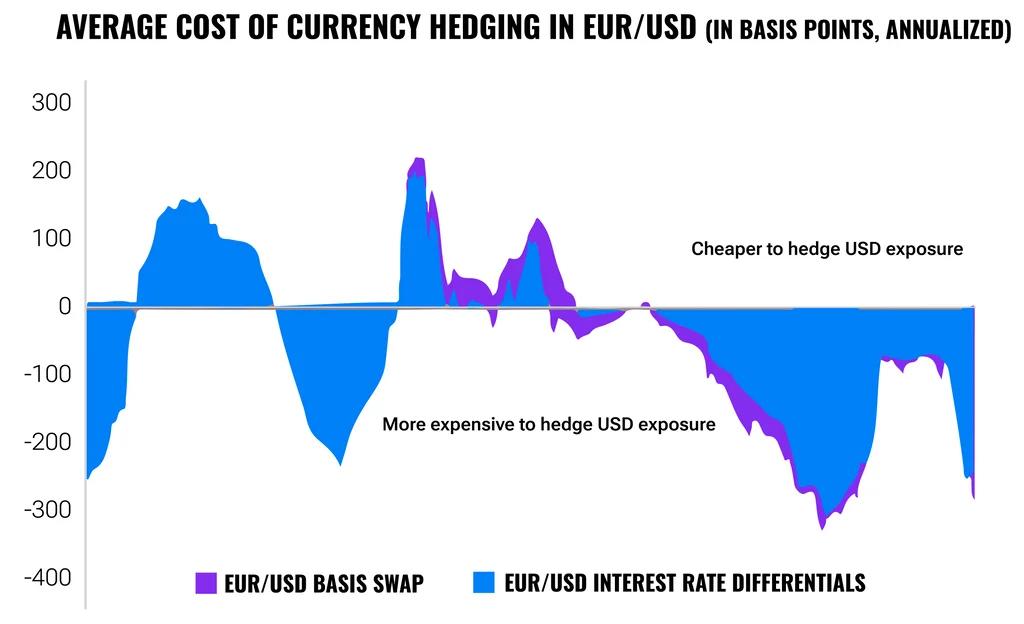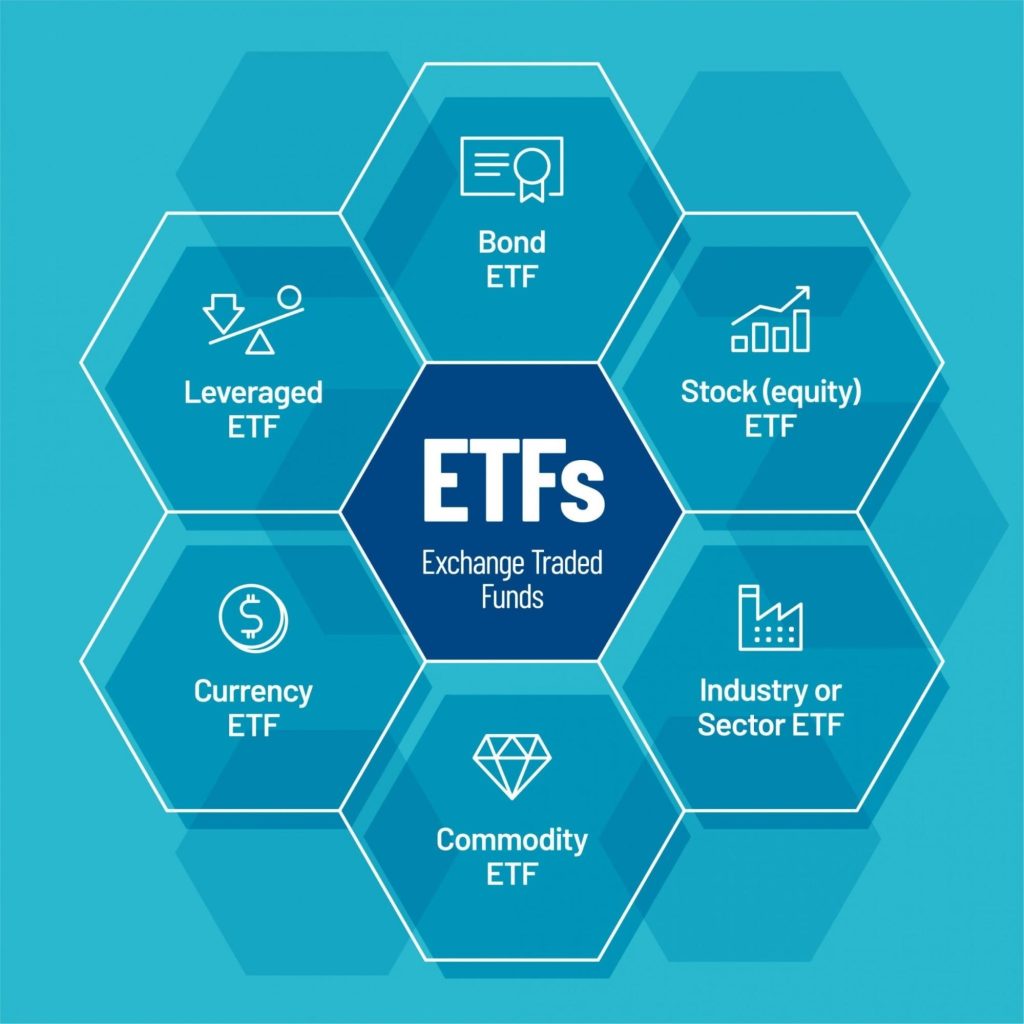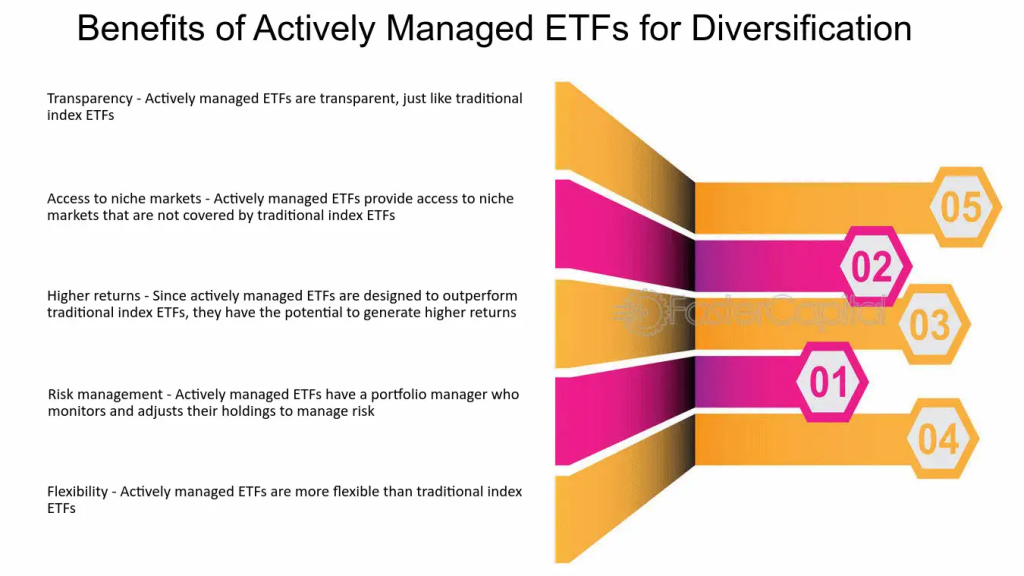Τοπικό: Διαφοροποιήστε το Χαρτοφυλάκιό σας
Στόχοι Μαθήματος:
- Understand Diversification in the EU: Learn how diversifying across countries in the Eurozone helps reduce country-specific risks. You’ll gain the ability to build portfolios that benefit from different economic growth levels και sector strengths.
- Explore Sector and Regional Opportunities: See how investing across various sectors and countries balances your portfolio by limiting the effect of poor performance in one area. You’ll understand how to combine high-growth industries με stable regions for smarter investing.
- Learn About Currency and Political Risk Management: Understand how to hedge risks when investing outside the Eurozone by using currency-hedged ETFs and other strategies. You’ll know when and how to reduce the effect of currency fluctuations και political changes.
- Use ETFs for Simplified Diversification: Discover how ETF (Exchange Traded Funds) can help you diversify across regions, sectors, or countries within Europe—easily and cost-effectively—through a single investment product.
- Recognize the Benefits of Actively Managed ETFs: Learn how actively managed ETFs προσφορά transparency, risk control, and flexibility by adjusting investments based on market trends. This will help you find more opportunities while still protecting your investment.
13.1 Diversify Your Portfolio
In the European Union, διαποικίληση plays a critical role in managing risk due to the unique economic, political, and regulatory landscape. Investors in the Eurozone benefit from both local and cross-border diversification strategies that leverage the economic integration of the region while managing country-specific risks.
Cross-Border Investments within the Eurozone
One of the primary diversification strategies for EU investors is cross-border investing within the Eurozone. The single currency and harmonized regulations under frameworks like MiFID II allow for easier investment across member states. This provides opportunities to spread risk and capture growth from different economies within the Eurozone.
- Diversifying Across Economies: The Eurozone comprises economies with varying levels of growth, inflation, and economic drivers. For instance, countries like Γερμανία και the Netherlands are industrial powerhouses, while Southern European countries σαν Ιταλία και Ισπανία offer exposure to sectors like tourism and agriculture. By investing across these economies, investors can reduce their exposure to country-specific risks and balance their portfolios with a mix of high-growth and stable markets.
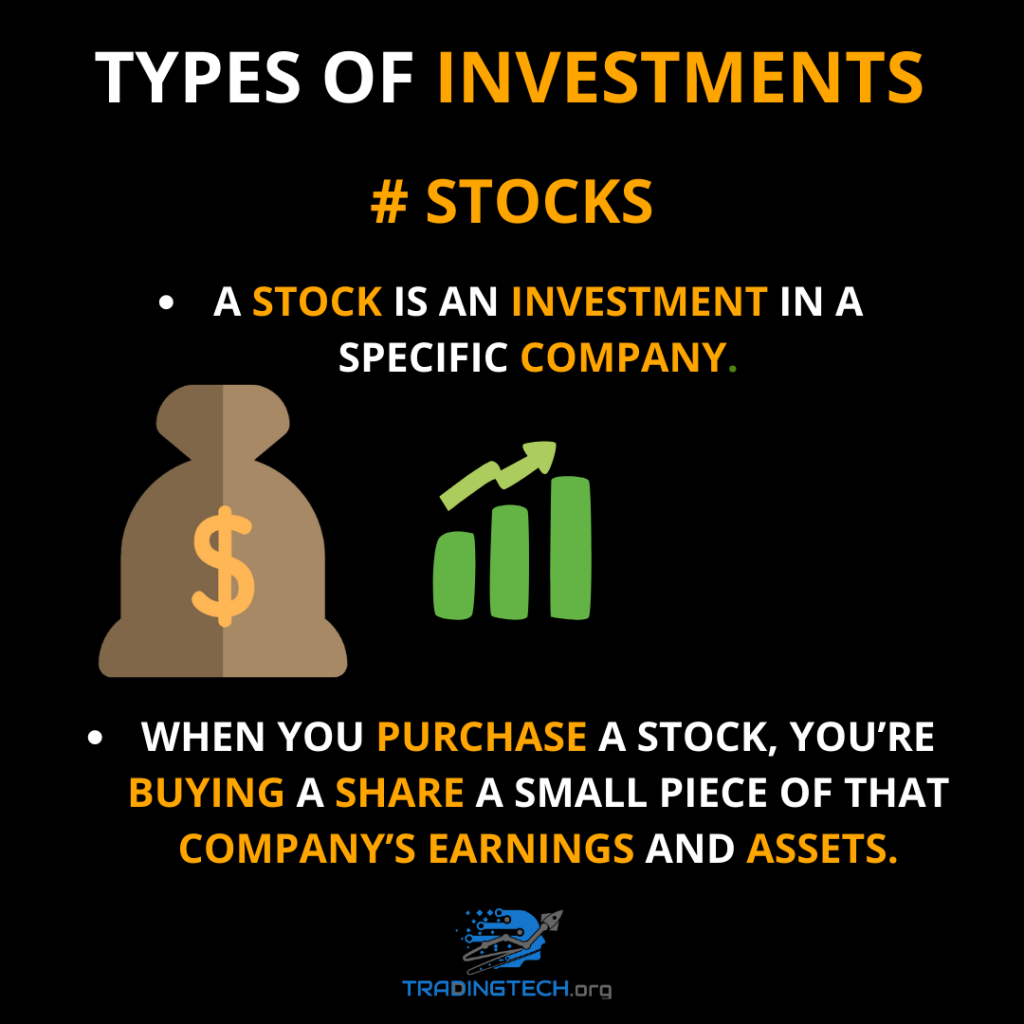
2. Sectoral Diversification Across Countries: Certain sectors dominate specific Eurozone countries. For example, αυτοκινητοβιομηχανία και βιομηχανοποίηση are key industries in Germany, while είδη πολυτελείας και φαρμακευτικά προϊόντα thrive in France. Spreading investments across countries with sectoral strengths ensures a more balanced portfolio, reducing the risk tied to any single country’s economic performance.
3. Currency Risks within the Eurozone: While the common currency (euro) eliminates direct currency risk between Eurozone member states, it does not negate the regional economic disparities that can affect investments. Cross-border investments help mitigate the impact of localized economic slowdowns. For instance, if one country faces political uncertainty or economic recession, investments in other Eurozone markets may help stabilize the portfolio.
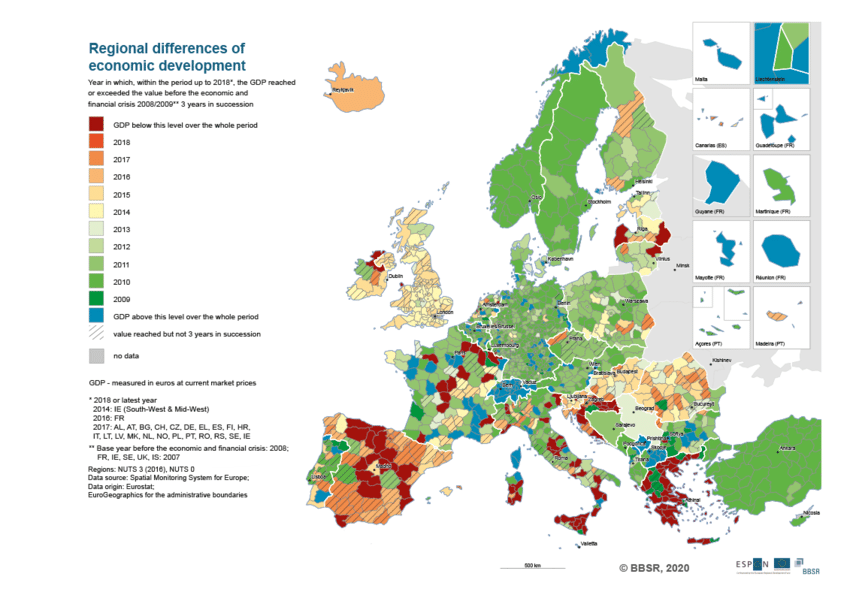
Εικόνα: Regional Differences of Economic Development in European Regions
Περιγραφή:
This map visualizes the regional economic development in Europe, indicating the year when each region’s ΑΕΠ (measured in euros at current market prices) reached or exceeded levels from before the 2008/09 economic and financial crisis for at least three years consecutively. Regions are color-coded by year, from 2009 to 2018, showing when economic recovery occurred. Regions that never surpassed pre-crisis GDP levels, lost at least three years of growth, or lack data are marked distinctly. The map uses varying shades of green, yellow, and red to depict this information across different European territories.
Βασικά συμπεράσματα:
- GDP recovery varied significantly across regions, with some achieving pre-crisis levels as early as 2009, while others only did so by 2018.
- Certain regions in Southern Europe struggled more with economic recovery, showing prolonged periods of GDP below pre-crisis levels.
- Regions that maintained GDP levels above pre-crisis levels throughout the period highlight economic resilience.
- Some areas experienced growth setbacks, marked by losing three or more years of GDP growth.
- The map demonstrates the economic disparity and varying recovery speeds across European regions.
Εφαρμογή πληροφοριών:
Κατανόηση regional economic recovery patterns is essential for επενδυτές, policymakers, και economists. It provides insights into which regions may offer better investment opportunities or require economic interventions. Investors can use this data to assess the economic stability and growth potential of specific regions, helping guide decisions related to επενδύσεις σε ακίνητα, business expansions, ή government policy development.
Hedging Currency and Political Risks Beyond the Eurozone
While Eurozone investors can diversify within the region, they may also choose to invest outside of the Eurozone, introducing currency and political risks. Hedging strategies help manage these risks:
- Currency-Hedged Investments: For investments outside the Eurozone, especially in non-euro-denominated countries like the UK ή Ελβετία, using currency-hedged ETFs or derivatives can protect investors from adverse currency fluctuations. This is particularly important when the euro fluctuates against major global currencies like the U.S. dollar or the British pound.
- Political Risk Diversification: Political events, such as Brexit, demonstrated the importance of political risk management in Europe. Investors can diversify political risk by holding investments across different EU countries to hedge against instability in any one region. For example, while the UK faced significant political uncertainty during Brexit, other Eurozone countries provided stability for diversified portfolios.
Εικόνα: Average Cost of Currency Hedging in EUR/USD (in Basis Points, Annualized)
Περιγραφή:
This line chart shows the average cost of currency hedging between the euro (EUR) και το U.S. dollar (USD), measured in basis points, on an annualized basis. It distinguishes between two components: the EUR/USD basis swap (purple line) and the EUR/USD interest rate differentials (blue line). The chart is divided into areas where it is either cheaper ή more expensive to hedge USD exposure. The fluctuations above the zero line indicate periods when it’s cheaper to hedge USD exposure, while the dips below zero represent times when it is more expensive.
Βασικά συμπεράσματα:
- Hedging costs fluctuate due to changes in basis swaps και interest rate differentials between the EUR and USD.
- Periods above zero imply lower costs for USD hedging, while periods below zero indicate υψηλότερο κόστος.
- The basis swap and interest rate differential lines help distinguish the drivers of hedging costs.
- Hedging costs can vary significantly, reflecting changes in market conditions και νομισματική πολιτική.
- Understanding these fluctuations is critical for investors managing συναλλαγματικός κίνδυνος.
Εφαρμογή πληροφοριών:
For investors exposed to currency fluctuations between EUR and USD, this information is crucial for effective risk management. Monitoring hedging costs helps in deciding when to hedge currency exposure, enabling cost-effective strategies to protect returns. It is particularly relevant for investors with cross-border portfolios ή multinational operations, guiding decisions on when and how to implement currency hedging tactics.
Regional ETFs for European Diversification
European-focused ETFs offer a simple and cost-effective way to achieve diversification across multiple countries within the Eurozone. Investors can choose from a wide range of ETFs that track different sectors, regions, and indices.
- Pan-European ETFs: These funds track major indices like the Euro Stoxx 50 ή MSCI Europe, providing exposure to the largest companies across the Eurozone. This allows investors to diversify across sectors and regions with a single investment.
- Sector-Specific ETFs: Investors can also diversify by sector using sector-specific ETFs that focus on industries like technology, financial services, or healthcare, providing exposure to high-growth industries across Europe.
- Country-Specific ETFs: Country-focused ETFs allow investors to gain exposure to individual markets, such as Γερμανία, Γαλλία, ή Ιταλία, offering targeted diversification. These ETFs are useful for balancing exposure to countries with different economic conditions or focusing on specific economic strengths.
Εικόνα: Benefits of Actively Managed ETFs for Diversification
Περιγραφή:
This visual illustrates the five key benefits of investing in actively managed Exchange-Traded Funds (ETFs) for diversification. It explains how these funds provide διαφάνεια, access to niche markets, higher returns, διαχείριση κινδύνου, και ευκαμψία. Unlike traditional index ETFs, actively managed ETFs are designed to outperform by adjusting their holdings based on market conditions, offering greater potential for return and risk adjustment.
Βασικά συμπεράσματα:
- Transparency: Actively managed ETFs maintain a high level of openness, similar to traditional index ETFs.
- Access to niche markets: They provide exposure to markets not usually covered by traditional index ETFs.
- Higher returns: With the potential to outperform index funds, they aim for enhanced returns.
- Risk management: These funds have portfolio managers actively adjusting holdings to manage risk.
- Ευκαμψία: They are more adaptable to market changes compared to traditional index ETFs.
Εφαρμογή πληροφοριών:
Κατανοώντας το οφέλη of actively managed ETFs can help investors seeking διαποικίληση while aiming for higher returns. These funds allow investors to adjust risk exposure and access less common market sectors. For those looking to optimize their portfolios, these ETFs can serve as a flexible και strategic tool in both rising and volatile market conditions.
συμπέρασμα
Diversification in the European Union offers unique opportunities due to the region’s economic integration and diversity. By investing across multiple countries and sectors within the Eurozone, investors can spread risk and capture the growth potential of different economies. Cross-border investments και sectoral diversification help reduce exposure to country-specific risks, while hedging strategies manage currency and political risks for investments beyond the Eurozone. Utilizing European ETFs further simplifies diversification, making it easier for investors to build well-rounded portfolios that align with their financial goals and risk tolerance.
Βασικές πληροφορίες μαθήματος:
- Cross-border diversification in the Eurozone allows investors to reduce country-specific risks and benefit from economic integration. By investing across countries like Germany, Spain, or Italy, investors gain access to a mix of stable and growing economies, improving portfolio balance.
- Sectoral diversification across countries reduces risk by investing in different industries that are strong in specific regions. For example, automotive investments may be concentrated in Germany, while tourism-related investments are more common in Spain, helping reduce reliance on one market sector.
- Currency risks within the Eurozone are minimized, but economic differences between countries still exist. By diversifying across several Eurozone economies, investors can avoid major losses if one country faces economic trouble or political uncertainty.
- The cost of currency hedging between the euro and other currencies like the USD can vary. Watching the cost trends helps investors decide the best time to hedge and minimize currency risk efficiently.
- European ETFs offer easy access to diversification, allowing investors to choose from pan-European, sector-specific, ή country-specific funds. These tools help spread investments while tailoring exposure to different opportunities in the EU.
Τελική δήλωση
Diversification is essential for building strong, balanced investment portfolios. This section teaches how spreading investments across regions, sectors, and asset types within and beyond the Eurozone can help reduce risk, manage volatility, and capture more stable returns over time.


